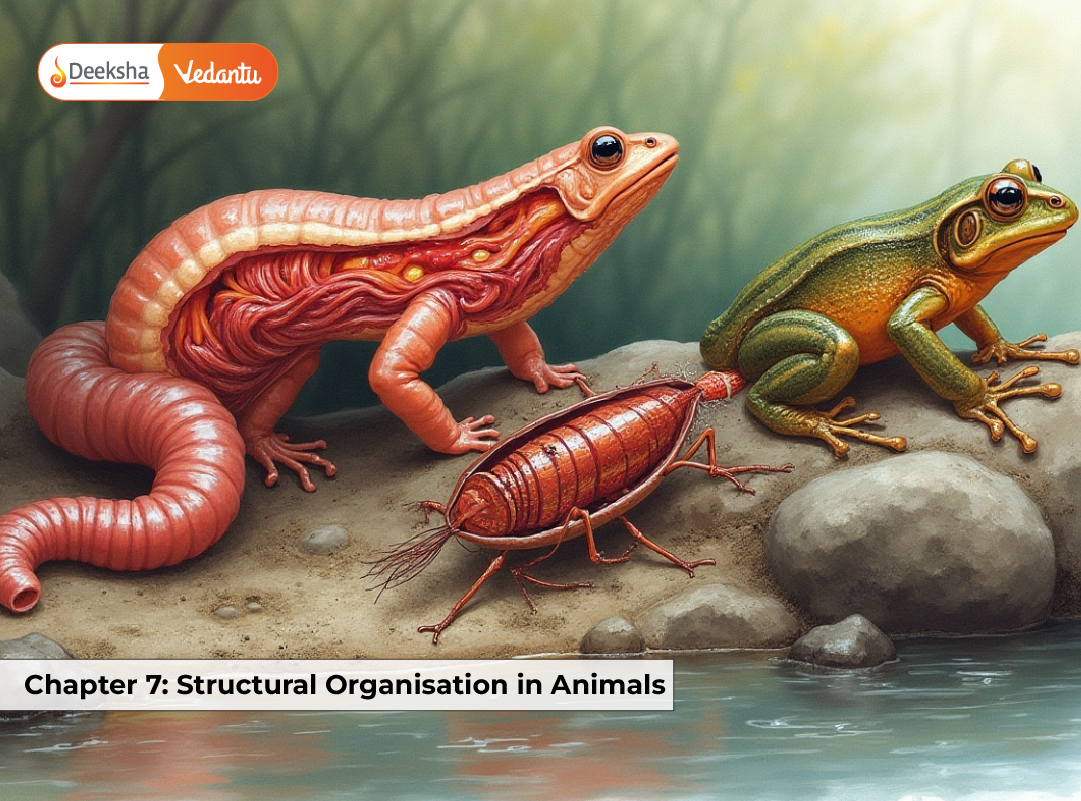Understanding the structural complexity in multicellular organisms is crucial for mastering Zoology in NEET. Chapter 7 of the NCERT Class 11 Biology textbook, “Structural Organisation in Animals,” provides detailed insights into how tissues, organs, and systems are organized in animals. This chapter bridges the microscopic world of cells and tissues to the macroscopic anatomy of animals such as earthworms, cockroaches, and frogs.
This content aligns closely with the previous chapters of Unit II: Structural Organisation in Animals and Plants, especially Chapter 6, where plant anatomy is discussed.
Importance for NEET
This chapter carries 1–2 questions in NEET annually, especially from the sections on animal tissues and the morphology and anatomy of the frog. Questions often test diagrams, terminology, and comparative anatomy. Thus, it is essential to remember key characteristics and features of each organism covered.
Animal Tissues
Animal tissues are broadly divided into four types, each specialized for a particular function:
1. Epithelial Tissue
- Covers body surface and lines cavities.
- Forms barriers and is involved in absorption, secretion, and protection.
- Types:
- Simple epithelium: single layer; e.g., squamous, cuboidal, columnar, ciliated.
- Compound epithelium: multiple layers; e.g., skin (protection).
- Specialized structures: microvilli (increased surface area), goblet cells (mucus secretion).
2. Connective Tissue
- Binds and supports body structures.
- Components: cells + matrix.
- Types:
- Loose connective tissue: areolar (between organs), adipose (fat storage).
- Dense connective tissue: tendons (muscle to bone), ligaments (bone to bone).
- Specialised connective tissue: cartilage, bone, blood.
3. Muscular Tissue
- Responsible for movement.
- Types:
- Skeletal: striated, voluntary, multinucleated.
- Smooth: non-striated, involuntary, single nucleus.
- Cardiac: striated, involuntary, branched with intercalated discs.
4. Neural Tissue
- Forms the brain, spinal cord, and nerves.
- Consists of neurons (transmit impulses) and neuroglia (support cells).
Morphology and Anatomy of Earthworm (Pheretima posthuma)
Morphology
- Segmented cylindrical body (~80-120 segments).
- Dark median dorsal line, clitellum (segments 14–16).
- Prostomium (mouth lobe), peristomium (surrounds mouth).
- Body wall: cuticle, epidermis, muscle layers, coelomic epithelium.
Anatomy
- Digestive system: Mouth → Buccal cavity → Pharynx → Oesophagus → Gizzard → Stomach → Intestine → Anus.
- Blood vascular system: Closed, dorsal and ventral vessels, 5 pairs of hearts.
- Nervous system: Ganglia and nerve cord.
- Reproductive system: Hermaphrodite. Testes (10 & 11), ovaries (13). Cocoon formation in clitellum.
Morphology and Anatomy of Cockroach (Periplaneta americana)
This section is critical for NEET, as many direct questions have been asked on insect anatomy. Focus particularly on identifying digestive and respiratory system components, reproductive differences, and sensory organs.
Morphology
The cockroach has a dorsoventrally flattened, elongated, and segmented body divided into three regions: head, thorax, and abdomen. Its brown chitinous exoskeleton is reinforced with sclerites for protection and flexibility. The head is triangular and shows significant cephalisation with compound eyes, long thread-like antennae for tactile sensation, and mandibulate mouthparts designed for biting and chewing.
- Head: Bears compound eyes, antennae, and chewing-type mouthparts.
- Thorax: Composed of prothorax, mesothorax, and metathorax—each bearing a pair of legs. The mesothorax and metathorax also carry forewings and hindwings respectively.
- Abdomen: Has 10 segments in both sexes, with external genitalia and anal cerci (sensory structures).
Anatomy
The internal anatomy of the cockroach is well-organized into various systems:
Digestive System
The alimentary canal extends from the mouth to the anus and is divided into three parts:
- Foregut: Includes mouth, pharynx, oesophagus, crop (food storage), and gizzard (grinding).
- Midgut: Primary site for digestion and absorption; has hepatic caecae (digestive glandular structures).
- Hindgut: Includes ileum, colon, and rectum for water absorption and feces formation.
Digestive enzymes from salivary glands and hepatic caecae aid in breaking down carbohydrates and proteins.
Circulatory System
The cockroach has an open circulatory system. Haemolymph (blood equivalent) flows freely in the haemocoel. The heart is a long, tubular structure with 13 chambers that pump haemolymph forward through aorta-like arteries. There is no network of blood vessels.
Respiratory System
The respiratory system consists of a network of tracheae that open externally through 10 pairs of spiracles. Air enters via spiracles and diffuses through thin tracheoles to reach tissues, ensuring direct oxygen delivery and efficient gas exchange.
Nervous System
The cockroach’s nervous system comprises:
- Central nervous system (CNS): A brain and a ventral nerve cord.
- Peripheral system: Connects CNS to body parts.
- Visceral system: Controls internal organs.
The brain is relatively small; control is majorly through segmental ganglia along the nerve cord.
Reproductive System
- Male: Testes (4–6), vas deferens, seminal vesicles, ejaculatory duct, and male genitalia. Spermatophores are formed during copulation.
- Female: Ovaries with ovarioles, oviducts, genital chamber, and spermatheca (stores sperms). The fertilized eggs are encased in oothecae and laid in safe crevices.
Excretory System
Malpighian tubules remove nitrogenous wastes (mainly uric acid) and help in osmoregulation. They empty into the hindgut.
Sense Organs
- Compound eyes: For vision.
- Antennae: Tactile receptors.
- Maxillary palps: Gustatory function.
- Cerci: Sensitive to vibrations and aid in predator detection.
The detailed anatomical features of cockroaches offer multiple NEET question possibilities, especially on reproductive parts, circulatory peculiarities, and respiratory structures. For clarity, here’s a comparative snapshot:
| Feature | Earthworm | Cockroach | Frog |
| Circulatory System | Closed | Open | Closed |
| Respiratory Organs | Skin | Tracheae | Lungs, skin, buccal cavity |
| Heart Chambers | 5 pairs of aortic arches | 13-chambered tubular heart | 3-chambered heart |
| Excretion | Nephridia | Malpighian tubules | Kidneys |
Morphology
- Body: Head, thorax, abdomen. Brown exoskeleton.
- Thorax bears 3 pairs of legs, 2 pairs of wings.
- Compound eyes, antennae, mouthparts (biting and chewing).
Anatomy
- Digestive system: Mouth → Pharynx → Oesophagus → Crop → Gizzard → Midgut → Hindgut.
- Circulatory system: Open, haemolymph with heart of 13 chambers.
- Respiratory system: Spiracles (10 pairs), tracheae, tracheoles.
- Nervous system: Ganglia and nerves.
- Reproductive system:
- Male: Testes (4–6), vas deferens, seminal vesicle.
- Female: Ovaries, oviducts, genital chamber. Ootheca (egg case).
Morphology and Anatomy of Frog (Rana tigrina)
Morphology
- Greenish skin, moist.
- Eyes with nictitating membrane.
- Hind limbs longer for jumping; forelimbs for landing.
- Cloaca present (common passage).
Anatomy
Frog’s internal anatomy is a favorite in NEET due to its varied systems and adaptive features. Diagrams are especially important here.
- Digestive system: Alimentary canal with associated glands.
- Respiration: Cutaneous, pulmonary, and buccal.
- Circulatory system: Closed; 3-chambered heart.
- Nervous system: Brain → Spinal cord → Nerves.
- Reproductive system:
- Male: Paired testes, vasa efferentia.
- Female: Paired ovaries, oviducts.
NEET-Focused Tips
Make sure to focus on the sections frequently targeted in past NEET papers. Earthworm’s reproductive and circulatory system, Cockroach’s sense organs, and Frog’s respiration types are high-yield areas. Diagrams, especially of tissues and organ systems, are often tested.
- Revise tissue types with functions and locations.
- Understand the structure-function relation in organs.
- Use tables to compare earthworm, cockroach, and frog features.
- Practice diagram-based questions.
Illustrative NEET Questions
- Which of the following animals has a closed circulatory system?
- a) Earthworm
- b) Cockroach
- c) Frog
- d) Both a and c
- Identify the epithelium found in the lining of blood vessels.
- a) Cuboidal
- b) Columnar
- c) Squamous
- d) Ciliated
- The respiratory structures of cockroach are:
- a) Lungs
- b) Tracheae
- c) Gills
- d) Book lungs
FAQs
1. What are the four types of animal tissues?
Epithelial, connective, muscular, and neural tissues.
2. Why is the frog’s heart called three-chambered?
Because it has two atria and one ventricle.
3. How do earthworms reproduce?
Earthworms are hermaphrodites and reproduce sexually by forming a cocoon.
4. How does respiration occur in cockroaches?
Via spiracles and a network of tracheae and tracheoles.
Conclusion
Questions from this chapter have consistently appeared in NEET. Focus on tissues, cockroach reproduction, and frog circulation. Use tables and visual aids to reinforce differences among organisms. With regular practice and diagram labeling, this chapter can help secure critical NEET marks.
Understanding animal tissues and anatomical adaptations helps build foundational Zoology knowledge for NEET. Be it the locomotion of frogs, the segmented body of earthworms, or the open circulation in cockroaches — each detail is a potential NEET MCQ. Prioritize visual learning and keep practicing with labeled diagrams to ace this chapter.




Get Social